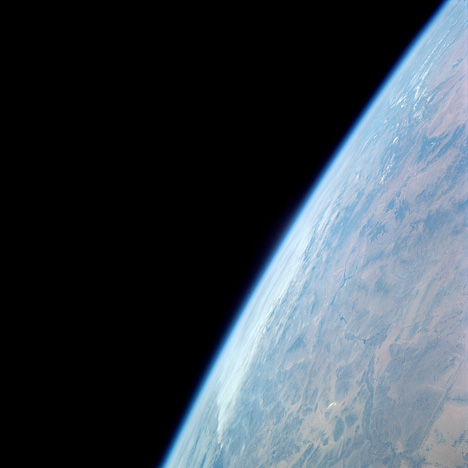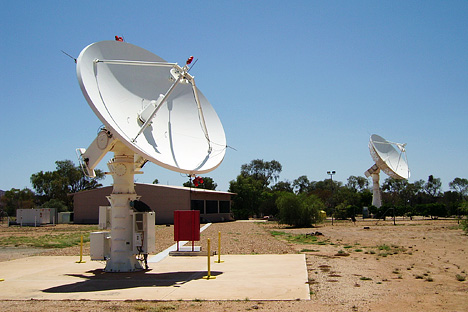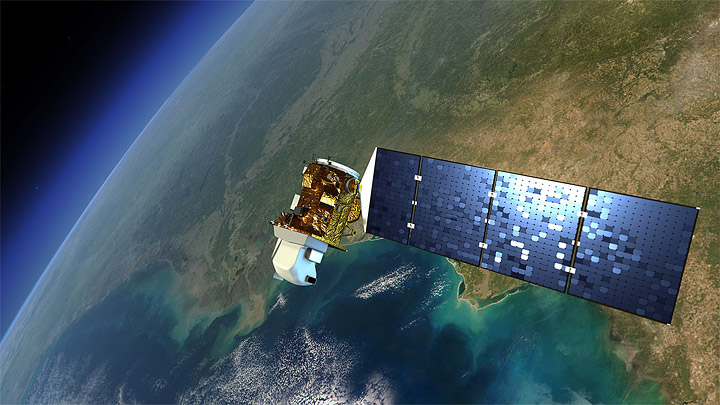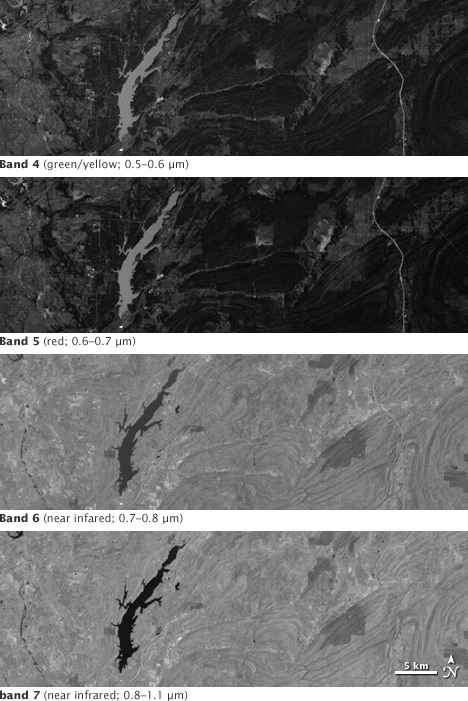

You can see a lot by just looking. —Yogi Berra
In 2011, scientists from North Carolina, France, and Peru saw that deforestation in a portion of the Amazon rainforest was proceeding at an unusual pace in an unexpected place. Images from the Landsat 5 satellite clearly showed that deforestation had increased six-fold over a six-year period in the remote Madre de Dios region of Peru, near the Bolivian border. No one knew why.
Compelled by the images, investigators visited the forest and found serious mercury poisoning affecting both the people and the wildlife. Driven by soaring gold prices, miners were clearing trees for gold. The result was not only further deforestation, but mercury pollution from the mining process.
Landsat images of the Madre de Dios region of Peru revealed proliferating gold mines deep in the Amazon Rainforest. (NASA images by Robert Simmon, using Landsat data from the USGS Global Visualization Viewer.)
Landsat actually did not see the mercury pollution; it saw deforestation where it should not have been happening. And Landsat compelled the scientists to investigate.
Without Landsat, America’s longest running Earth-imaging satellite program, it is unlikely scientists would have seen the pollution or the deforestation at Madre de Dios for years, and the health of local residents would have been seriously affected. Landsat may have saved lives.
Since 1972, Landsat has collected more than three million images that describe two generations of human imprints on Earth, as well as the planet’s effects on humanity. The Landsat archives tell an unparalleled story of the planet’s land surfaces, and they are a practical, thought-provoking reservoir of things we need to watch for and to be warned of. The imagery tells a story rich in information that can help us better find ways to peacefully and prosperously accommodate seven billion people on one small planet.
It is said that the Landsat program was inspired by photographs taken by the Apollo astronauts. Those pictures showed a glorious, glowing blue orb hanging in the infinite black of space. It was a series of photos that changed forever how we view our world.

This photograph of the southwestern United States, taken in November 1966 during the Gemini XII mission, was among those that inspired the Landsat program. (NASA Astronaut photograph from the March to the Moon collection.)
Stewart Udall, United States Secretary of the Interior for Presidents Kennedy and Johnson, remembered one particular image: a picture of pollution spewing from power plants in the Four Corners area of his home state of Arizona. Knowing there was pollution on Earth was one thing; seeing it unambiguously from orbit was an entirely different matter. Clearly, satellites provided a new way to look at our home as we never had before.
The idea was not entirely new. In 1951, the British science fiction author Arthur C. Clarke suggested that satellites orbiting over the poles could take measurements and pictures of the world as it rotated below. In the mid-1960s, Udall urged the Johnson Administration to do just that: create a program of Earth-observation satellites. A joint program between the Department of Interior and NASA eventually produced the Earth Resources Technology Satellite (ERTS), which would take broad images of the Earth’s surface.
By July 23, 1972—twenty-one years after Clarke envisioned it—an Earth-watching, civilian science satellite was launched into a near-polar orbit. ERTS instruments recorded information in four spectral bands: red, green, and two infrared. More than 300 researchers—a third of them from outside the United States—were employed to analyze the new data, partly because no scientist had seen the likes before. The satellite operated until 1978, its longevity and the quality of the pictures exceeding all expectations.

The Earth Resources Technology Satellite (ERTS, later renamed Landsat 1) launched aboard a Delta 900 from Vandenberg Air Force Base on July 23, 1972. (NASA photography courtesy Landsat science team.)
During a January 1975 press briefing, NASA Associate Administrator Charles Mathews told reporters that upon launch ERTS-B would become Landsat 2, and the orbiting ERTS would be designated Landsat 1. Matthews explained that a planned mission to study the oceans was going to be called Seasat, so NASA decided it was appropriate to rename its land sensing program Landsat.
An early discovery by Landsat 1 was a tiny, previously unknown island off the coast of Newfoundland. When a Canadian scientist was lowered some years later from a helicopter to explore the island, he discovered that the only inhabitant, a polar bear, was unhappy with the intrusion. The bear charged, and the scientist left quickly. The island was named Landsat Island.
Landsat 2 was launched in 1975, and Landsat 3 in 1978. Both were considered experimental, but the success of the technology prompted efforts to turn Landsat into an operational program. In 1979, President Jimmy Carter laid the groundwork to transfer the Landsat program to the National Oceanic and Atmospheric Administration (NOAA) in the U.S. Department of Commerce, changing its status from a research program to an operational monitoring program. Landsat 4 was launched in 1982 and Landsat 5 in 1984—the same year that Congress passed a law commercializing the program.
These images from 1972 and 2011 show the transformation of agriculture near Garden City, Kansas from rectangular fields with traditional irrigation to circular fields irrigated with central-pivot systems. In false-color, vegetation is red and bare ground is brown. (NASA images by Robert Simmon, using Landsat data from the USGS Global Visualization Viewer.)
A year later, the newly created Earth Observation Satellite Co. (EOSAT), took over the operations of Landsat 4 and 5. But commercialization proved to be unworkable. The need recover its costs from users had forced NOAA to dramatically raise Landsat data prices (as much as 600 percent for some products). By the time EOSAT took over, cost increases had driven away all but the largest customers (principally the military and the oil and mining companies). Image acquisition became more customer-driven, resulting in more limited coverage.
Bad luck continued. In 1987, the main radio transmitter on Landsat 5 failed. Without a data recorder on the satellite, it seemed like it might be impossible to download data from outside the U.S. In 1989, funding shortages forced NOAA to order EOSAT to prepare to turn off the two remaining satellites.
But things began to turn around. On Landsat 5, mission operators worked out plans with colleagues in Australia and several other nations to downlink the data remotely and send it back to the U.S. This network of stations allowed Landsat 5 to acquire considerable data outside of North America. The Administration of President Bush also found the funds to keep Landsat 4 and 5 operational—a good thing, because Landsat 6 failed upon launch in 1993 and ended up in the Indian Ocean.

The Alice Springs data acquisition facility in central Australia is one of the many receiving stations that allow Landsat data to be collected internationally. [Photograph by Mike Pasfield, Geoscience Australia. Creative Commons attribution (CC BY 3.0), Commonwealth of Australia]
Amidst the turmoil, Congress passed the Land Remote Sensing Policy Act. The 1992 legislation returned operation of the program to the government and authorized the launch of Landsat 7, a satellite that would be entirely government owned and operated. The U.S. Geological Survey was charged with distributing the data at government (nonprofit) rates. Today, the USGS distributes Landsat data over the Internet for free, and usage has exploded.
Despite all of the ups and downs, Landsat 5 and 7 operated far beyond their designed lives. The Thematic Mapper (TM) on Landsat 5 only recently gave out after 27 years of imaging; around the same time as TM shut down, operators managed to turn the Multispectral Scanner System (MSS) back on after years of dormancy. Landsat 7 continues its work as well, 13 years after launch.

Landsat Data Continuity Mission. (NASA.)
The eighth satellite, dubbed the Landsat Data Continuity Mission (LDCM), is scheduled for launch in 2013. It will be the next chapter for the longest-operating Earth-observing program in the world.
The original plan for Landsat was to rely solely on special television-style cameras called return beam vidicons (RBVs) to do the imaging. RBVs have three cameras, each using a colored filter—one for the blue-green part of the spectrum, one for yellow-red, and one for the red-infrared part—and each revealing a different aspect of the physical world.
But while ERTS/Landsat 1 was being designed, Hughes Aircraft came up with a new instrument that used the emerging technology of fiber optics and imaged the Earth in strips. As the satellite orbited, the scanner would take six strips of pictures at 90-degree angles, perpendicular to the direction it was traveling. It also took pictures in four different parts of the spectrum. For instance, one band could show how plants were absorbing chlorophyll; another could observe the water content of leaves; a third could see moisture in the soil—all valuable things to record if you are tracking vegetation or biomass. Hughes called it the Multispectral Scanner System (MSS), and NASA decided to add it as a second imager.

The Multispectral Scanner System aboard the early Landsat satellites imaged the earth in four spectral bands, ranging from 0.5 micrometers (green), to 1.1 micrometers (near infrared). Each band brings out different features in the landscape, and ultimately can be combined to make color images. (NASA images by Robert Simmon, using Landsat data from the USGS Global Visualization Viewer.)
Many scientists had concerns about the reliability of the new approach. The MSS had a moving part—an oscillating mirror—that some feared might break or jam. Researchers also were unhappy with the idea of having strips of images that would have to be merged.
Then the satellite was launched and the first MSS images came down. They had jaw-dropping beauty and exquisite detail. To make the victory complete, the RVB malfunctioned and was shut down a month after launch, while the MSS kept sending images for years.
Landsat images the Earth’s surface in a series of scenes 185 kilometers (115 miles) wide. Landsat 7 is currently collecting data, but suffered a failure in 2003 that leaves gaps between scan lines. This Landsat 7 image, collected on June 26, 2012, shows the Ouachita Mountains, along the border between Oklahoma and Arkansas. (NASA image by Robert Simmon, using Landsat 7 data from the USGS Global Visualization Viewer.)
For Landsat 4 and 5, Hughes replaced the MSS with the Thematic Mapper (TM), a next-generation, somewhat higher resolution imager. With a 30-meter (100-foot) ground resolution along a 185-kilometer (115-mile) swath of land, Landsat could now provide worldwide coverage between 81°N latitude and 81°S every 16 days, at a resolution that made it easier to see large-scale patterns and changes on nearly every land surface.
By the time Landsat 7 launched in 1999, the satellite had an eight-band, enhanced version of the mapper (ETM+), powerful enough to build a worldwide database with as much as 400 detailed images per day. Unfortunately, the scanner malfunctioned in 2003 and 22 percent of each scene was lost. But image blending techniques have allowed the operators to worked around the image losses. Landsat 7 is still sending back its data 13 years after its launch.
Perhaps the greatest contribution of Landsat is the ability to observe the Earth’s land surfaces through time. To take a snapshot of something shows you only what is true for that split second; to show what is happening over generations is different. Time is part of the scaffolding of science.
Landsat can take snapshots showing the state of crops in California or North Dakota, volcanic hot spots in Yellowstone, or mineral deposits in Death Valley. And it can see all of them in ways never possible before. The satellites can take snapshots over the course of a few days, graphically capturing the damage from Hurricane Katrina, the Tohoku tsunami, a tornado in the hills of Massachusetts, or a forest fire in Arizona. Government officials can watch disaster recovery as it happens.
Landsat has done all that and something more. It has assembled a complete picture of all the landmasses on Earth. If you have Google Earth on your computer or smart phone, you are seeing Landsat images as you zoom in.
The longevity of Landsat allows scientists to monitor natural and human-induced changes on the Earth’s surface. This pair of images shows the growth of Beijing from June 21, 1978, to June 8, 2011. In these false-color images, vegetation is red and bare ground or human development (roads, buildings) are tan to brown. (NASA images by Robert Simmon, using Landsat 3 & 5 data from the USGS Global Visualization Viewer.)
But the true gift of watching the Earth is the long view. Landsat can monitor a changing planet over time: the appearance and disappearance of barrier islands; melting glaciers in Greenland and the Antarctic; rising sea levels; the evolution of forests in the Rockies; and the erosion of coastlines in Alaska. Landsat has measured the use and misuse of water resources in the American West, and helped planners keep an eye on urban growth.
And so it was that Landsat found the mining and pollution in Peru that no one had noticed before. With the price of gold skyrocketing (360 percent in 10 years from 2001 to 2011), unlicensed miners began pouring into Peru’s Madre de Dios. They cleared 12,500 acres from the forest between 2003–2009. Landsat images showed local deforestation increasing at a rate of 26 percent per year.
While the deforestation itself was not great enough to pose much of a threat to the forest, the mercury was. Miners use mercury to extract gold from rocks. It vaporizes during the process and becomes airborne, eventually poisoning water supplies.
Mercury was getting into the fish, and the people were eating the fish. They were also drinking the water. Tests of local residents showed that the closer they were to the mines, the more mercury in their bodies.
The stewards of the rainforest now have work to do. Landsat looked; the scientists saw. Lives will be saved.